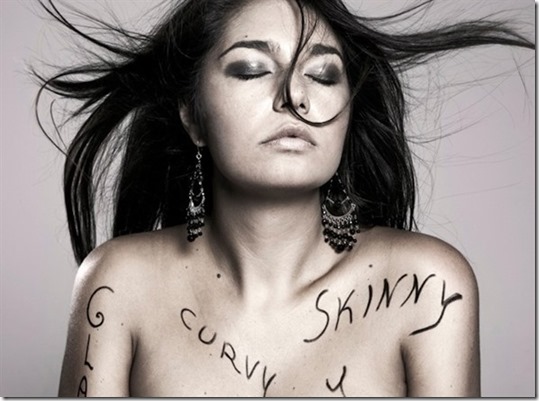The Curvy World Posted by Serena on Feb 6, 2014 in Italian Language, News
Have you ever looked critically at a photo of yourself and felt like doing a little tweaking with Photoshop? I must admit that I have, but I’m not very clever with photo editing software. However, many people who spend a lot of their time under the spotlight go to great lengths to have the ‘perfect’ silhouette, wonderful skin, or simply to appear one (or two) sizes smaller than they actually are. I’m not against the idea, but I’m well past that delicate age when appearance and image are so important to one’s self-esteem. And anyway, Geoff says he likes me just as I am! I must admit though that I do get a sense of satisfaction when I see ‘before and after Photoshop’ pictures of ‘beautiful’ people.
Geoff recently showed me an interesting article on the subject from the women’s blog “La 27esima Ora” in “il Corriere della Sera”. It’s an interview with Elisa D’Ospina, a ‘curvy’ fashion model for ‘comfortable sizes’ who has taken up an important mission in her life. Elisa goes into schools to talk with adolescents about the importance of diversity in appearance and of feeling good about your body. Here is a shortened version of the article, with a Vocabulary and grammar explanation below. You can read the article in its entirety by clicking here:
Elisa D’Ospina ha solo trent’anni ma dal 2005 fa la “modella curvy”. Grazie alle sue forme, grazie al suo aspetto “piacente” come dice lei stessa, ora ha diverse rubriche su riviste, internet e tv dove discute di immagine femminile.
Quando hai iniziato ad occuparti di immagine?
«Nel 2007 ho iniziato a denunciare i blog che consigliavano metodi per dimagrire velocemente e poi ho iniziato a fare alcuni incontri nelle scuole con un programma sull’accettazione della diversità, su quanto sia positivo essere diverse, dove mantengo un capitolo speciale su Photoshop e sulla distorsione della figura della donna»
Cosa ti ha spinto a impegnarti in questo percorso?
«Mia madre è stata bulimica: grazie alla sua esperienza mi ha sempre incoraggiato a credere in me stessa. Poi dopo i primi incontri con le studentesse, che alla fine mi abbracciavano piangendo, ho pensato che non potevo più smettere … Se penso che i disturbi alimentari sono il secondo motivo di decesso tra gli adolescenti dopo gli incidenti stradali, non posso e non voglio fermarmi»
Come hai impostato l’approccio con i ragazzi?
«Tendenzialmente gli incontri durano dalle due alle quattro ore, prima faccio un discorso io di circa due ore con video e slide; poi ho sempre con me un medico nutrizionista o uno psicologo e dopo ancora non faccio mai mancare una buona ora per il dibattito»
E i ragazzi cosa ti chiedono? Ci fai un esempio di alcune domande?
«Prima di tutto mi chiedono come si fa a riconoscere l’inizio dell’anoressia e del disturbo alimentare. La domanda spesso inizia con il famoso “una mia amica…” e poi mi aspettano a fine lezione per parlare di loro stesse. Subito dopo mi chiedono come ho fatto a dire di no ogni volta che mi hanno chiesto di perdere peso, ad esempio per un lavoro. E ancora mi chiedono come ne possono parlare a casa. Per questo il web ha così tanto successo: siti e social network sono un luogo dove i ragazzi riescono a parlare ed esprimersi, cosa che invece non riescono a fare con i genitori»
Tra loro ci sono anche dei ragazzi?
«I maschi mi danno manforte! Dicono che sono i primi ad amare la carne e che delle volte a loro dispiace quando le fidanzate o le madri si fanno problemi che loro non vedono. L’anoressia maschile purtroppo è in crescita, ma diciamo che nelle scuole ho trovato qualche caso di vigoressia»
You can find out more about Elisa D’Ospina by clicking on the photo below to visit her website:
Vocabulary and grammar (click on the embedded links for further information):
Grazie alle sue forme, grazie al suo aspetto “piacente” = thanks to her shape/curves, thanks to her “pleasing” appearance. Piacente is the present participle from the verb piacere (to like, to please)
i blog = notice that in Italian we don’t pluralise foreign words when we use them in the plural, i.e. we don’t say “blogs” or “blogghi”. However, the article, adjectives and so on which refer to the foreign word must be changed to the plural, therefore il blog (sing. masc.) becomes i blog (pl. masc.)
i disturbi alimentari = eating disorders
prima faccio un discorso io = first I give a speech. Notice the use of the personal pronoun io in an emphatic position at the end of the sentence. This is because she wants to make clear that she is not the only one talking during the meeting, but there is also space for the doctor and the students to speak.
come ne possono parlare = how they can talk about it. In Italian we say “parlare di qualcosa” (to talk of something), so we use the pronoun “ne” to mean “of it”
I maschi mi danno manforte! = The guys back me up!
sono i primi ad amare la carne = they are the first ones to love flesh/a curvy body
a loro dispiace = they are sorry. The verb dispiacere (lit. to displease) works in the same way as the verb piacere (to please/like, e.g. a loro piace = they like). However, dispiacere doesn’t mean “to dislike”, but “to be sorry” e.g. mi dispiace = I’m sorry
vigoressia = vigorexia, or more informally “bigorexia”. A body image disorder which involves an excessive obsession with muscularity and body building, with negative consequences on social, educational or occupational life.
Click on the photo above to watch an interview with Elisa (with English subtitles) in the Italian version of Vogue online.

Build vocabulary, practice pronunciation, and more with Transparent Language Online. Available anytime, anywhere, on any device.







Comments:
Bernie:
Io penso che questa ragazza e bellissima